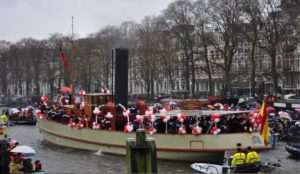This was always one of our favorite mornings of the year when we lived in Amsterdam…the second Sunday in November, Sinterklaas arrives via steamship from Spain!! People gather on bridges, streets and boats to celebrate his annual arrival!
In the Netherlands, Saint Nicholas’ Eve (December 5, he also shares my birthday!) is THE holiday tradition and time of gift-giving. It celebrates Saint Nicholas, the patron saint of children and sailors. Sinterklaas wears a long red cape, white bishop’s dress and hat, holds a long gold staff and carries a big book that tells whether each child has been nice or naughty this year. He is said to be very rich, lives in a castle in Spain, and likes to give presents on his birthday rather than receive them.
 Sinterklaas’ helpers are “Zwarte Piet” (or Black Pete) and come from Saint Nicholas’ past. (A VERY suprising sight when you see them the first year but once you know the story you get it!) The story says 3 small Moorish boys were sentenced to death for a crime they did not commit. The bishop intervened and they were saved. To show their gratitude, the boys stayed with Sinterklaas to help him on rooftops on Sinterklaas night to deliver presents. Their black skin being from their Moorish background.
Sinterklaas’ helpers are “Zwarte Piet” (or Black Pete) and come from Saint Nicholas’ past. (A VERY suprising sight when you see them the first year but once you know the story you get it!) The story says 3 small Moorish boys were sentenced to death for a crime they did not commit. The bishop intervened and they were saved. To show their gratitude, the boys stayed with Sinterklaas to help him on rooftops on Sinterklaas night to deliver presents. Their black skin being from their Moorish background.
Traditionally, in the weeks between Sinterklaas’ arrival and December 5, before children go to bed they put their shoes next to the fireplace or door with a carrot or some hay for his white horse, Amerigo. The next day they will find some candy or a small present in their shoes from a Zwarte Piet or Sinterklaas himself if they’ve been good. If they’ve been naughty the story says Sinterklaas and his Black Petes carry willow branches in their sack to spank them. Or worst case is they’re put in the sack and taken back to Spain for the rest of year (take me!).

Today’s celebration, in addition to his arrival via ship from Spain, welcomes Sinterklaas to town with a parade… he rides Amerigo through town and his Zwarte Piet throw candy and small, round, ginger bread-like cookies, called pepernoten or kruidnoten, into the crowd from their big sacks (YUM!).
Sinterklaas is even the basis for the North American Santa Claus. It is often claimed that during the American War of Independence the inhabitants of New York City, a former Dutch colonial town known then as New Amsterdam, reinvented their Sinterklaas tradition, as Saint Nicholas was a symbol of the city’s non-English past.
Presents, cookies, candy and even a possible trip to Spain… what’s not to love! Check it out if you’re ever in Amsterdam mid-November![/fusion_builder_column][/fusion_builder_row][/fusion_builder_container]


